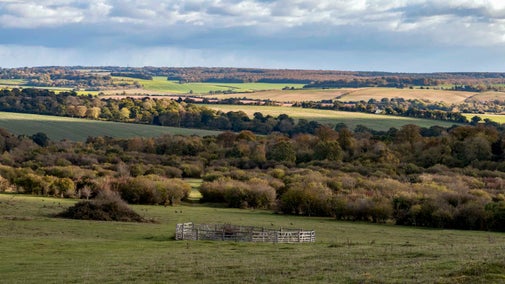2020–22
2020–22
The team carry out ongoing checks and care to make sure the growing trees are thriving.

We’ve planted 6,500 new trees to extend the existing woodland at Curbridge Nature Reserve, thanks to a generous donation from global company SC Johnson.
The £85,000 donation enables us to expand and protect a vital nature conservation site: creating the ancient woodland of the future while protecting the ancient woodland of today, for generations to come.
The development of the site includes planting 6,500 trees and creating a new pond - important wildlife habitats that will benefit endangered species such as dormice. The new woodland will help combat the effects of heavy footfall and natural erosion on a site of ecological and historical importance.
On the banks of the River Hamble, Curbridge Nature Reserve consists of a SSSI (Site of Special Scientific Interest) ancient woodland, and salt marsh, reed bed and estuary mudflats which make up a designated SPA (Special Protection Area) and SAC (Special Area of Conservation). It is also a Ramsar site: a wetland of international importance.
There has been woodland along the River Hamble for hundreds of years, providing habitats for birds, butterflies and key endangered species.
The area is well-loved by the local community, frequented by walkers and home to a ‘fairy tree’, which is decorated with tokens and wishes from visitors.
But the popularity of Curbridge Nature Reserve has led to heavy footfall and the existing ancient woodland suffers from groundwater runoff from the surrounding urban areas.
In addition to a number of existing urban centres in close proximity, there are a further 3,500 houses planned for the North Whitely development opposite the reserve.
These pressures have created areas of soil erosion and compaction on veteran trees. Bankside trees are also being lost to the natural tidal influences of the river.
The woodland is unable to naturally regenerate back away from the estuary edge in most places due to other land uses such as stables and smallholdings.

Tree planting began in February 2019. Species have been chosen to reflect those found naturally in the neighbouring woodland: shrub and understorey such as hazel, field maple, wild service and hawthorn, and upper canopy species such as oak, lime and cherry.
Rides and glades are included in the planting scheme, providing open areas for wildflowers and grasses to ensure the diverse habitats which are important for endangered wildlife species such as bats, butterflies, and dormice. The pond will also add to this rich network of varied habitats.
The project will require years of aftercare after the initial planting. This includes spraying and mulching of weeds around each tree to heighten their chance of survival, thinning of failed saplings, and the removal of tree guards after several years.
The new woodland will benefit local communities by providing natural green spaces for walks, dog walkers and outdoor play. A pathway will be diverted through the newly planted area, helping to ease the pressure on the adjacent ancient woodland and allowing it to recover.
Regular visitors to the site will be able to watch this woodland mature into a lasting legacy for wildlife.
2020–22
The team carry out ongoing checks and care to make sure the growing trees are thriving.

Everyone needs nature, now more than ever. Donate today and you could help people and nature to thrive at the places we care for.

SC Johnson is a family company dedicated to innovative, high-quality products and a long-term commitment to the environment.
Explore Curbridge Nature Reserve on the River Hamble, an ancient riverside woodland important for wild birds, waterfowl, salt marsh and rare invertebrates.

We’re doing lots of work to look after the countryside sites of Stockbridge Down, Stockbridge Marsh and Curbridge Nature Reserve in order to provide key habitats for rare species.

Explore Mottisfont’s diverse estate, criss-crossed by the crystal-clear River Test, and south Hampshire countryside sites of Stockbridge Down and Marsh and Curbridge Nature Reserve.

We believe that nature, beauty and history are for everyone. That’s why we’re supporting wildlife, protecting historic sites and more. Find out about our work.

Find out more about the funding the National Trust receives from grants, and the projects it has helped support.
